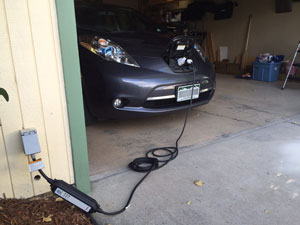Charging Electric Vehicles at Home
Most drivers of electric vehicles (EVs)—which include all-electric vehicles and plug-in hybrid electric vehicles (PHEVs)—charge their vehicles overnight at home using AC Level 1 or AC Level 2 charging equipment. Residential equipment is frequently installed in garages, but outdoor installation and use are also safe, even if the vehicle is being charged in the rain. Outdoor installations require outdoor-rated equipment. Charging at multifamily housing requires additional considerations and may be more like public charging than charging at a single-family home.
Installing Charging Equipment in Your Home

EV owners may install Level 2 (240 V) charging equipment in their homes for a faster charge, or opt for the Level 1 cordset provided with the vehicle as shown here.
Many EV owners are able to meet their daily driving range requirements by charging overnight with Level 1 equipment, requiring no additional cost or installation, provided that a power outlet on a dedicated branch circuit is available near their parking location. Level 2 charging equipment can be installed for drivers with less regular schedules, longer commutes, or EVs with large batteries that require more than overnight (or the typical dwell time) to fully charge. State and utility incentives may be available to help offset the cost of charging equipment.
Most Level 2 products have standard safety features and status lights. More advanced, "smart" Level 2 products have features such as data collection, user interface systems, enhanced displays, charging timers, communications capabilities, and keypads. Purchasing safety-certified equipment is recommended, such as the products certified under the ENERGY STAR label, which are tested by a nationally recognized testing laboratory, along with having a certified electrical contractor.
Electricians can inform homeowners whether their home has adequate electrical capacity for vehicle charging. Some homes might have insufficient electric capacity for Level 2 equipment. However, a qualified electrician can add circuits to accommodate the capacity needed for Level 2 charging.
The City of San Jose, California, was one of the first to issue requirements for installing vehicle charging systems in single-family homes and duplexes, and explains the permitting process and location planning for a home charging unit. In recent years, other cities have followed suit, such as Seattle’s tip sheets for both residential and commercial EV charging installations.
Complying with Regulations
Charging equipment installations must comply with local and state codes and regulations. Appropriate permits may be required from the local building and permitting authorities.
EV charging infrastructure is considered a continuous load by the National Electrical Code (NEC). Your electrical contractor should understand and use the appropriate NEC for a safe and code-compliant installation. NEC Article 625 contains most of the information applicable to charging equipment. If possible, consult vehicle manufacturer guidance for information about the required charging equipment and learn the specifications before purchasing equipment or electrical services.
In many areas, a site installation plan must be submitted to the permitting authority for approval before installation.
Electricity Costs for Charging
The fuel efficiency of an EV may be measured in kilowatt-hours (kWh) per 100 miles. To calculate the cost per mile of an EV, the cost of electricity (in dollars per kWh) and the efficiency of the vehicle (how much electricity is used to travel 100 miles) must be known. If electricity costs ¢10.7 per kWh and the vehicle consumes 27 kWh to travel 100 miles, the cost per mile is about $0.03.
If electricity costs ¢10.7 per kilowatt-hour, charging an EV with a 200-mile range (assuming a fully depleted 54 kWh battery) will cost about $6 to reach a full charge. To compare the fueling costs of individual models of conventional and electric vehicles, see the Vehicle Cost Calculator.
For EV charging, the stability and planning benefits of household electricity rates offer an attractive alternative compared to traditional types of transportation. Learn more from the report: Comparing Energy Costs per Mile for Electric and Gasoline-Fueled Vehicles.

